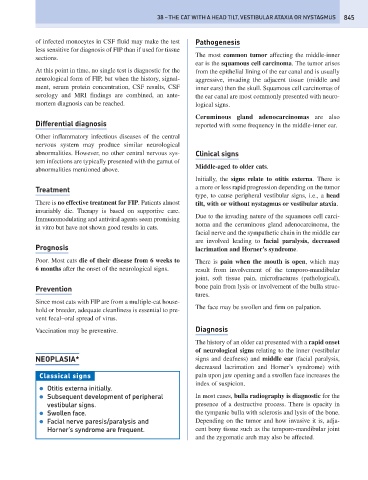Page 853 - Problem-Based Feline Medicine
P. 853
38 – THE CAT WITH A HEAD TILT, VESTIBULAR ATAXIA OR NYSTAGMUS 845
of infected monocytes in CSF fluid may make the test Pathogenesis
less sensitive for diagnosis of FIP than if used for tissue
The most common tumor affecting the middle-inner
sections.
ear is the squamous cell carcinoma. The tumor arises
At this point in time, no single test is diagnostic for the from the epithelial lining of the ear canal and is usually
neurological form of FIP, but when the history, signal- aggressive, invading the adjacent tissue (middle and
ment, serum protein concentration, CSF results, CSF inner ears) then the skull. Squamous cell carcinomas of
serology and MRI findings are combined, an ante- the ear canal are most commonly presented with neuro-
mortem diagnosis can be reached. logical signs.
Ceruminous gland adenocarcinomas are also
Differential diagnosis reported with some frequency in the middle-inner ear.
Other inflammatory infectious diseases of the central
nervous system may produce similar neurological
abnormalities. However, no other central nervous sys- Clinical signs
tem infections are typically presented with the gamut of
Middle-aged to older cats.
abnormalities mentioned above.
Initially, the signs relate to otitis externa. There is
Treatment a more or less rapid progression depending on the tumor
type, to cause peripheral vestibular signs, i.e., a head
There is no effective treatment for FIP. Patients almost tilt, with or without nystagmus or vestibular ataxia.
invariably die. Therapy is based on supportive care.
Due to the invading nature of the squamous cell carci-
Immunomodulating and antiviral agents seem promising
noma and the ceruminous gland adenocarcinoma, the
in vitro but have not shown good results in cats.
facial nerve and the sympathetic chain in the middle ear
are involved leading to facial paralysis, decreased
Prognosis lacrimation and Horner’s syndrome.
Poor. Most cats die of their disease from 6 weeks to There is pain when the mouth is open, which may
6 months after the onset of the neurological signs. result from involvement of the temporo-mandibular
joint, soft tissue pain, microfractures (pathological),
Prevention bone pain from lysis or involvement of the bulla struc-
tures.
Since most cats with FIP are from a multiple-cat house-
The face may be swollen and firm on palpation.
hold or breeder, adequate cleanliness is essential to pre-
vent fecal–oral spread of virus.
Vaccination may be preventive. Diagnosis
The history of an older cat presented with a rapid onset
of neurological signs relating to the inner (vestibular
NEOPLASIA* signs and deafness) and middle ear (facial paralysis,
decreased lacrimation and Horner’s syndrome) with
Classical signs pain upon jaw opening and a swollen face increases the
index of suspicion.
● Otitis externa initially.
● Subsequent development of peripheral In most cases, bulla radiography is diagnostic for the
vestibular signs. presence of a destructive process. There is opacity in
● Swollen face. the tympanic bulla with sclerosis and lysis of the bone.
● Facial nerve paresis/paralysis and Depending on the tumor and how invasive it is, adja-
Horner’s syndrome are frequent. cent bony tissue such as the temporo-mandibular joint
and the zygomatic arch may also be affected.

